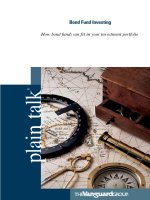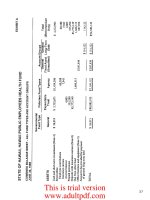CHAPTER NINE: INVESTMENT PORTFOLIO MANAGEMENT potx
Bạn đang xem bản rút gọn của tài liệu. Xem và tải ngay bản đầy đủ của tài liệu tại đây (423.62 KB, 14 trang )
CHAPTER NINE: INVESTMENT
PORTFOLIO MANAGEMENT
06/08/2011 1
06/08/2011 2
INVESTOR
An investor is a party that makes an investment into
one or more categories of assets equity, debt
securities, real estate, currency, commodity,
derivatives such as put and call options, etc. with
the objective of making a profit.
Inviduals
Organizations: Financial entities including
Brokerages, Banks, Funds…
06/08/2011 3
INVESTMENT PROCESS
- Analyze the market
- Evaluate expected returns and risks
- Design the optimized portfolio
06/08/2011 4
Risk aversion
U =E(r) -0,5A. Б
2
Б
2 =
0 -> U = E(r) (Risk free portfolio)
Risk of portfolio and Diversification
Return and Risk of portfolio:
)(
n
1i
iip
ERwER
[8-9]
Active Management
– The process of managing investment portfolios by
attempting to time the market and/or select
“undervalued” stocks to buy and “overvalued” stocks to
sell based upon company research, investigation and
analysis
Passive Management
– The process of managing investment portfolios by trying
to match the performance of an index or asset class of
securities as closely as possible by holding all or a
representative sample of the securities in the index or
asset class
– Does not use market timing or stock selection strategies
PORTFOLIO MANAGEMENT
06/08/2011 5
Investment Decision Matrix:
Where Do You Fit In?
Market Timers and Stock Selectors
*
Where the common crowd hangs out
Preference of active management,
high-cost “gurus
*
”
Heavy on investment hype
Stock Selectors
Preference of stockbrokers and many financial
advisors
*
High cost, high turnover, high taxes
Market Timers
Tactical analysis
*
(with no proven results)
Tax inefficient
Short-term outlook
The Informed Investor
Based on academic research and data
*
As much as 40% of institutional invested dollars
The prudent investors
Receive market returns
Where YOU should be
(and where we are)
1.
2.
3. 4.
06/08/2011 6
• Asset Class Investing
– Stocks and Bonds
– US and International
– Large Cap and Small Cap
– Growth and Value
– Short-Term and Long-Term Maturity
06/08/2011 7
• Why Use Passive Asset Class Investing?
– Lower portfolio turnover
– Lower operating expenses
– Lower transaction costs
– Greater tax-efficiency
– Long-term perspective
– Broad diversification/risk reduction
– Control of asset allocation
– Passive asset class funds capture separate dimensions
of worldwide returns
06/08/2011 8
Passive versus Active Portfolio
Management
• Review of Market Efficiency
• Anomalies
• Market Timing
• A theoretical model of active portfolio
management (Treynor-Black)
• Quantitative Investment Management
06/08/2011 9
Passive Management
• Buy and Hold
• Indexation
• Active management must beat these
strategies on a net risk adjusted return basis!
• What if markets are efficient?
06/08/2011 10
Treynor-Black Model
• Suppose you can identify securities that you
expect to outperform (or underperform) on a
risk-adjusted basis
• How do you exploit this model?
06/08/2011 11
Treynor-Black Model: Assumptions
• Analysts can only produce quality analysis on a small
number of securities
• There is a passive market portfolio (M)
• Forecasts of return (E(r
M
) and risk (s) exist
• Determine abnormal return (a) for analyzed
securities
• Find optimal weights of analyzed securities to create
active component (A)
• Combine A, M and risk-free asset to achieve
efficiency
06/08/2011 12
Treynor-Black: Construction (Step 1)
• Assume: r
i
= r
f
+ b
i
(r
M
- r
f
) + e
i
• For analyzed security k:
r
k
= r
f
+ b
k
(r
M
- r
f
) + e
k
+ a
k
=> estimate a
k
, b
k
, s
2
(e
k
)
• To construct A:
w
k
= (a
k
/s
2
(e
k
))/(S[a
i
/s
2
(e
i
)])
=> determine a
A
, b
A
, s
2
(e
A
)
06/08/2011 13
Treynor-Black: Construction (Step 2)
• w
0
= (a
A
/s
2
(e
A
))/[(E(r
M
)-r
f
)/s
2
M
]
• w
*
= w
0
/(1+(1-b
A
)w
0
)
• w
0
is the proportion of A in the new, enhanced
market portfolio (M
‘
)
06/08/2011 14









